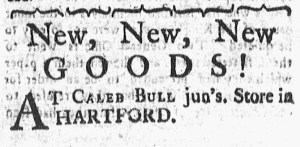What was advertised in a colonial American newspaper 250 years ago today?

“Good GOODS!”
Caleb Bull, Jr., had experience deploying crafty headlines to draw attention to his advertisements in the Connecticut Courant. In the spring of 1772, he ran an advertisement that consisted almost entirely of the headline: “New, New, New GOODS! AT CALEB BULL jun’s. Store in HARTFORD.” He inserted an advertisement with a similar headline in the March 22, 1774, edition of the Connecticut Courant. “Good GOODS!” it proclaimed.
Some of the headlines for notices that recently appeared in that newspaper may have inspired Bull to devise something playful and out of the ordinary for his own advertisement. At the beginning of the month, William Beadle alluded to the Boston Tea Party when he offered “Best Bohea TEA, Such as Fishes never drink!!” Matthew Talcott’s notice declared, “Make Way! A Probationer for New Gate!” in the previous issue. That issue also carried William Prentice’s advertisement for “Cheap GOODS.” That headline did not merely announce that Prentice sold goods; it also made an appeal to price. For eighteenth-century readers, “cheap” meant inexpensive rather than inferior quality.
The following week, Bull placed his own advertisement for “Good GOODS!” It served as a counterpoint to Prentice’s “Cheap GOODS” advertisement that ran once again. In this instance, the headline did indeed market the quality of the items offered for sale. The shopkeeper also made an appeal to price, assuring prospective customers that they would pay “a moderate Adva[n]ce from the COST.” In other words, Bull marked up his merchandise only slightly. He sacrificed larger profits in favor of presenting consumers with bargains, a means of competing with the “Cheap GOODS” available at another store in Hartford.
With experience publishing innovative headlines for his advertisements, Bull may have perused recent issues of the Connecticut Courant, noticed similarly provocative headlines, and determined that the time was right to make his own intervention in the public prints. If that was the case, he monitored advertisements in the local newspaper for style as well as substance, then composed copy accordingly.

